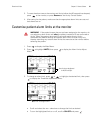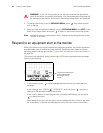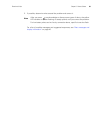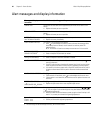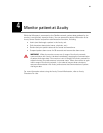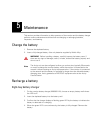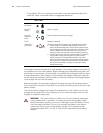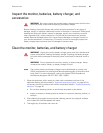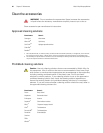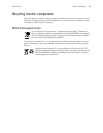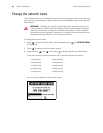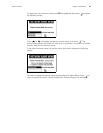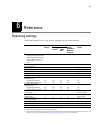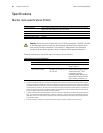
Directions for Use Chapter 5 Maintenance 45
Inspect the monitor, batteries, battery charger, and
accessories
Before cleaning, thoroughly inspect the monitor and all accessories for any signs of
damage, cracks, or improper mechanical function of the keys or connectors. While gently
bending and flexing the cables, inspect for damage, cracks, cuts, abrasions, extreme
wear, exposed wires, or bent connectors. Confirm that the connectors are securely
seated. Remove damaged items from use and report damage or improper function to
your service department. At least every 12 months, be sure to thoroughly inspect the
battery charger case and power cord for damage or extreme wear.
Clean the monitor, batteries, and battery charger
1. Wipe the equipment with a nearly dry clean cloth moistened with one of the
approved cleaning solutions listed in “Approved cleaning solutions” on page 46. Do
not use any solution or solution with similar constituents listed in “Prohibited cleaning
solutions” on page 46.
a. Do not allow cleaning solution to accumulate anywhere on the device.
b. Inspect to ensure no cleaning liquid is present in connector openings, latches, or
crevices.
2. After cleaning, thoroughly remove residual cleaning solution by wiping all surfaces
with a clean soft cloth dampened with water.
3. Thoroughly dry all surfaces with warm air.
WARNING Be sure to unplug the monitor battery charger power cord from the
electrical power outlet before inspecting the battery charger.
WARNING Unplug the monitor battery charger power cord from the electrical
power outlet before cleaning the battery charger. Exposing the battery charger
to liquids while connected to electrical power could result in electrical shock or
fire.
WARNING Do not autoclave the monitor, battery, or battery charger. Never
immerse the monitor, battery, or battery charger in liquid.
Note
The monitor, battery, and battery charger may be disinfected to comply with
OSHA requirements for cleaning and decontaminating spills of blood and other
body fluids. For more information, refer to the Federal OSHA Standard on
bloodborne pathogens: 29 CFR 1910, 1030, 12/6/91.



